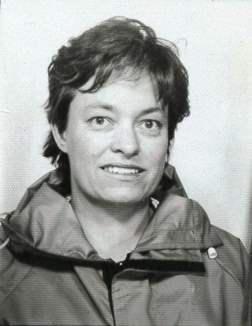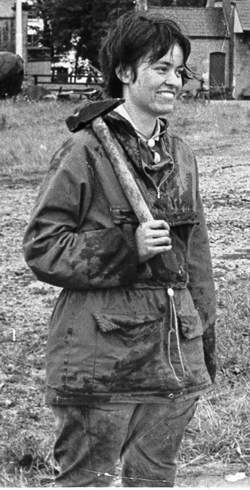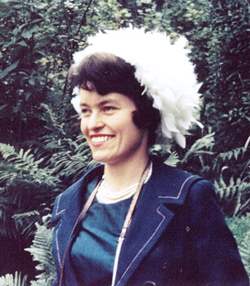 In March of this year, Julia Hubbard died. This was almost 40 years after I first met her, in the bowels of King’s College London. In 1976 I was just entering the office of Charles Curtis, my undergraduate supervisor at the University of Sheffield, when the phone rang. It was Julia enquiring if Chas had any students who wanted to do a PhD. He looked up from the phone, saw me standing there and asked, “Do you want to do a PhD in Australia on coral reefs?” I gasped. “Here talk to Julia Hubbard,” he said, “She has a NERC funded PhD position and is looking for someone who is handy and can scuba dive.”
In March of this year, Julia Hubbard died. This was almost 40 years after I first met her, in the bowels of King’s College London. In 1976 I was just entering the office of Charles Curtis, my undergraduate supervisor at the University of Sheffield, when the phone rang. It was Julia enquiring if Chas had any students who wanted to do a PhD. He looked up from the phone, saw me standing there and asked, “Do you want to do a PhD in Australia on coral reefs?” I gasped. “Here talk to Julia Hubbard,” he said, “She has a NERC funded PhD position and is looking for someone who is handy and can scuba dive.”
I picked up the phone and she started to explain the project. I did not understand a word she said (I rarely did), but considering that I had skipped most of my Geology classes, I thought that this was my fault and that I should investigate the opportunity further. The next day I arrived at King’s College on the Strand and was introduced to the rabbit warren which was the Geology Department. Situated in the old Surrey Hotel and sandwiched between Aldwych Tube Station and various bits of King’s College, both new and dating back to its original founding in 1829, the building could be kindly described as characterful. As was Julia.
That visit did not enlighten me any further as what the project was all about, but I nevertheless accepted the position and two months later I was on my way to Heron Island, Australia where for three months Julia and I explored the reefs together and I learnt a little about carbonate sediments. I was working with ‘The Dolly-Bird of Geology’ according to another of my University of Sheffield professors.
I returned to London in December 1976 with a treasure trove of coral material - and with introductions from Julia to the various laboratories across London, I started to implement the one-paragraph project for which Julia had obtained the NERC award. Three years later, with a successful PhD under my belt, I realised that Julia Hubbard had been way ahead of her time. While Robin Bathurst and Robert Ginsburg were pioneers of the concept of Modern Comparative Sedimentology, they only snorkeled. Julia donned diving equipment and engaged in hand-to-hand combat with carbonate sediments using the recently invented diving technology.
 She was also a pioneer in emphasising the significance of ‘bugs’ as modifiers of the sedimentary record and made me aware of the importance of early alteration of carbonate material - a principle which has fundamentally guided my approach to studying carbonates. She had an infectious enthusiasm. Who could forget her home-made films which depicted her making a transect across a carbonate bank? Her somewhat unsteady progress, a result of oversized fins and uneven relief, is still a vivid memory all these years later. She would have been right at home with the current love affair involving carbonate microbialites.
She was also a pioneer in emphasising the significance of ‘bugs’ as modifiers of the sedimentary record and made me aware of the importance of early alteration of carbonate material - a principle which has fundamentally guided my approach to studying carbonates. She had an infectious enthusiasm. Who could forget her home-made films which depicted her making a transect across a carbonate bank? Her somewhat unsteady progress, a result of oversized fins and uneven relief, is still a vivid memory all these years later. She would have been right at home with the current love affair involving carbonate microbialites.
Julia was born during the London Blitz of 1940, the daughter of an architect who was involved in the post-war reconstruction of the Middle East. As a consequence a great deal of her childhood was spent in this region. According to her brother she developed a later interest in geology and after taking additional courses in London, she was accepted to Bedford College located in Regents Park. She followed up her undergraduate research with a PhD working on the Carboniferous reefs around Sligo in NW Ireland. In 1966 she accepted a position as lecturer at King’s College, London.
At that time she could really be described as a pioneer in the field as there were only two women geologists at the University of London. They were known as the quiet one and the unquiet one. Guess which one was Julia! Females were so rare in the field that during introductory remarks at one meeting, the chairman addressed the audience as ‘Lady and Gentlemen’.
At King’s Julia’s research shifted from the ancient to the modern, working on reefs in Australia, Africa and the Caribbean. In addition to myself she mentored several other graduate students, some with unexpected career paths. Alistair Crame, a palaeontologist currently at the British Antarctic Survey was joint student with the Natural History Museum who worked on the Pleistocene reefs of the Kenyan coast. Derek Kinchington was a secondary school biology teacher who completed his PhD initially part time on the calcification of modern cold water corals using biological approaches. Based on these skills he worked for many years in viral research, specifically targeting HIV. Her final student who was worked on microbial mechanisms of calcification sadly never completed her dissertation.
As a result of the unfortunate and some would argue ill-conceived ‘rationalisation’ of geology departments across the UK in the mid-1980s, the Department at King’s College was amalgamated with several others in London and relocated to the Royal Holloway Site outside London. Julia Hubbard, along with her colleague Jake Hancock, refused to move. Julia received only limited support for her work after this although she continued to attend meetings related to coral reefs, both locally and internationally.
 She formed the Geological Studies Unit at King’s College which provided teaching support to other departments. She continued to attend meetings, particularly in London and the Geological Society of London as well as international meetings relating to coral reefs. After I moved to the University of Miami in 1983, I met her several times in Miami, as well during my frequent transits through London. Derek and I had lunch with her in Hampstead or downtown at our favorite Indian Restaurants.
She formed the Geological Studies Unit at King’s College which provided teaching support to other departments. She continued to attend meetings, particularly in London and the Geological Society of London as well as international meetings relating to coral reefs. After I moved to the University of Miami in 1983, I met her several times in Miami, as well during my frequent transits through London. Derek and I had lunch with her in Hampstead or downtown at our favorite Indian Restaurants.
She retired in 2005, but continued to hang out at the Geological Society and send me cryptic messages which my wife (coincidentally one of Jake Hancock’s students) found great pleasure in deciphering. Her communications/missives tended to be hand-written and dashed off with an enthusiasm that made their contents both visually and academically difficult to interpret.
Many acquaintances and colleagues will have different recollections of Julia. Although by nature somewhat reserved, she was a very kind person. Some will remember her as someone who was difficult to understand, others remember as an intellect way ahead of her time. I remember her as a combination of both of these, and someone whose academic record underestimates her contribution towards the field of Modern Comparative Sedimentology.
Peter Swart